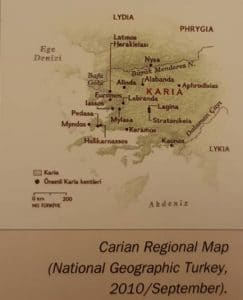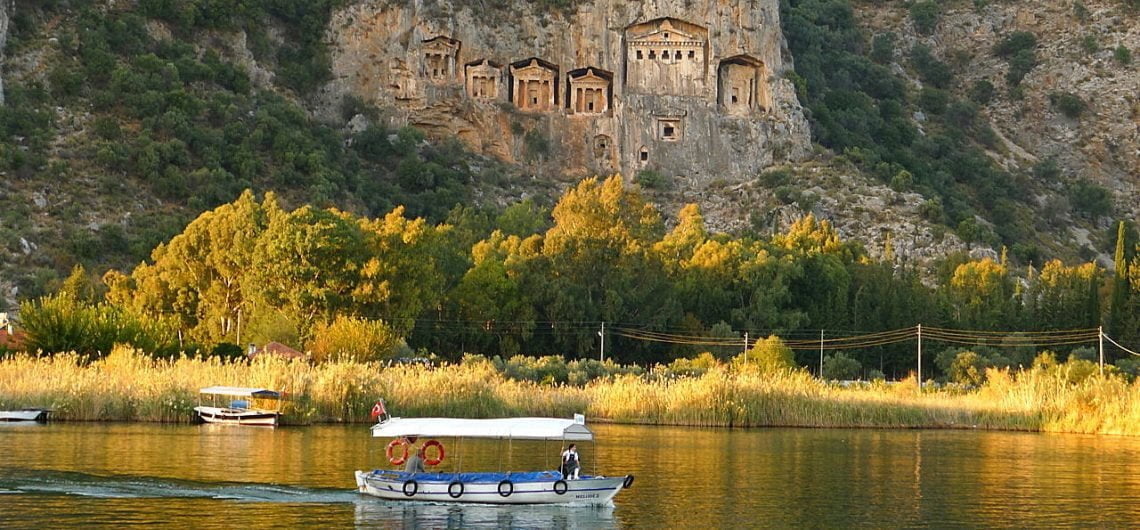“Nestor leads the Carians with barbarous tongues.
They live in Miletus, on mount Phytion of many leaves”
Homer
In the Anatolia of antiquity many people some of whom were natives of the land and others immigrants, lived in separate regions defined by geographical boundaries Historians and geographers of the First Era used to give the names of places according to their inhabitants. That is why Caria means Land of the Karians.” This country of mountains, highlands and plateaus cover the south of today’s Aydın, the southwest of Denizli and the entirety of Mugla (apart from Fethiye). This expansive area encompasses the lace-like Aegean coast, bays, peninsulas and islands.
 The Carians, an indigenous people of Anatolia, managed to preserve its culture from the 3rd millennium BC to 400 AD. According to Strabo, who lived in the 1st century the origins of the name Caria was the word “Karka,” meaning “tufted helmet.” In the Anatolian Luwian language, “Karka” also means “protruding rock, promontory and mountain peak.” The region mentioned as “Karuwa,” “Country of High Pinnacles” in Luwian records dating back to 1000 BC is probably Caria. These two names define the steep terrain and sinuous coasts of the country of the Kar very accurately. Caria began at the Maeander River (Büyük Menderes) and was encircled by lonia and Lydia to the north and Phrygia and Pisidia to the northeast. However, its southeast border with Lycia is a subject of debate. While some ancient sources state that one side of the Bay of Telmesos (Fethiye) belonged to Caria and the other to Lycia, some sources pull this border back to the Calbis (Dalyan) River. In both cases, Caunos is located on Caria’s border with Lycia, therefore featuring the cultural characteristics of both regions. Although Caunos was considered a Carian city in antiquity. Scylax, an important geographer and mapmaker of the 4th century BC, indicated that the city was within the boundaries of Caria. Herodotus’ reply to the question “Who were the inhabitants of Caunos?” was “a different people.”
The Carians, an indigenous people of Anatolia, managed to preserve its culture from the 3rd millennium BC to 400 AD. According to Strabo, who lived in the 1st century the origins of the name Caria was the word “Karka,” meaning “tufted helmet.” In the Anatolian Luwian language, “Karka” also means “protruding rock, promontory and mountain peak.” The region mentioned as “Karuwa,” “Country of High Pinnacles” in Luwian records dating back to 1000 BC is probably Caria. These two names define the steep terrain and sinuous coasts of the country of the Kar very accurately. Caria began at the Maeander River (Büyük Menderes) and was encircled by lonia and Lydia to the north and Phrygia and Pisidia to the northeast. However, its southeast border with Lycia is a subject of debate. While some ancient sources state that one side of the Bay of Telmesos (Fethiye) belonged to Caria and the other to Lycia, some sources pull this border back to the Calbis (Dalyan) River. In both cases, Caunos is located on Caria’s border with Lycia, therefore featuring the cultural characteristics of both regions. Although Caunos was considered a Carian city in antiquity. Scylax, an important geographer and mapmaker of the 4th century BC, indicated that the city was within the boundaries of Caria. Herodotus’ reply to the question “Who were the inhabitants of Caunos?” was “a different people.”Source: Koycegiz – Dalyan A Journey Through History Within The Labyrinth of Nature, (pages: 114), Altan Türe, 2011, Faya Kültürel Yayınları


Comments